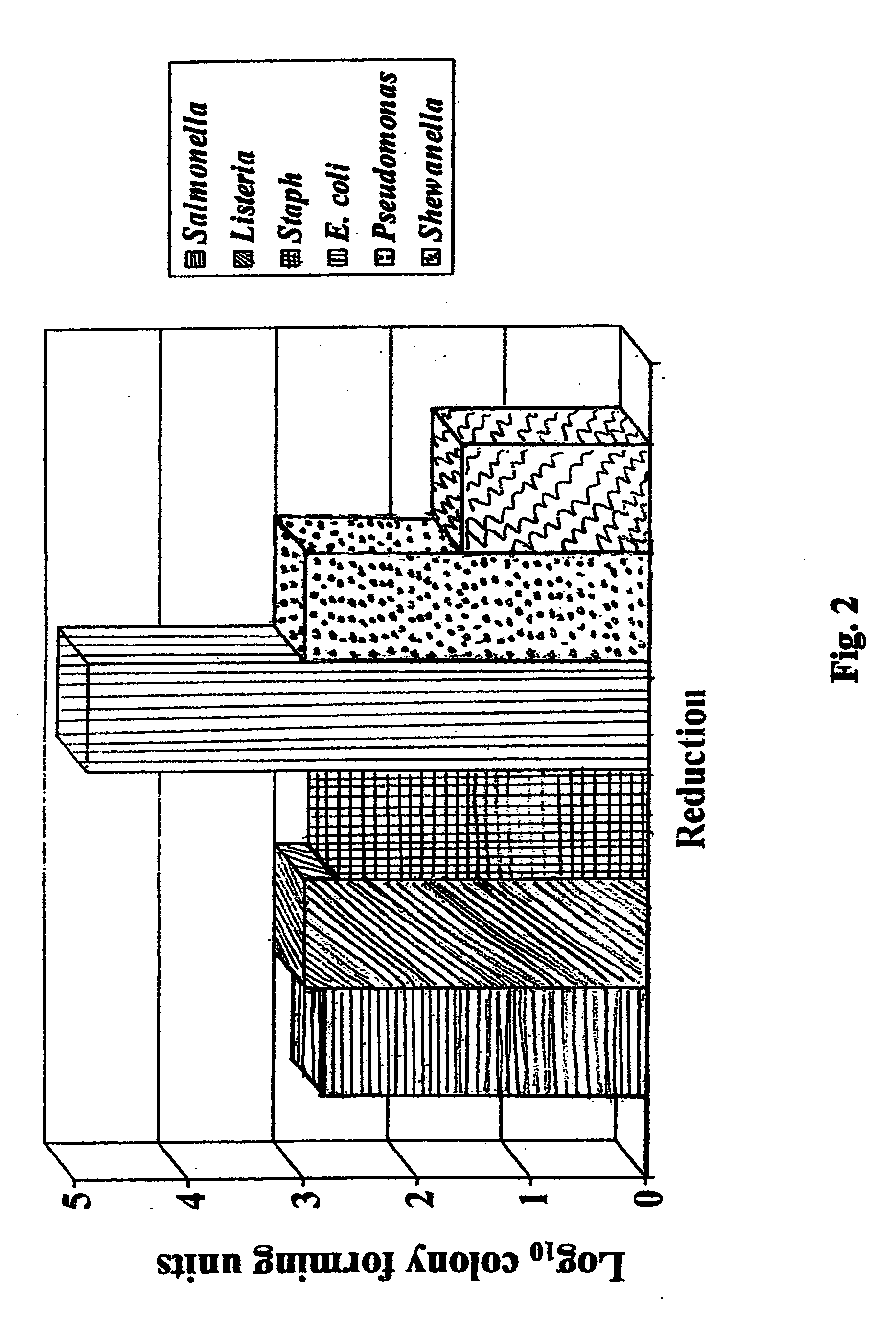Antimicrobial food additive and treatment for cooked food, water and wastewater
a technology of food additives and food waste, which is applied in the field of antimicrobial agents, can solve the problems of contaminated potable water and wastewater coming from various natural and industrial sources, carrying and nourishing and nourishing the potential for illness and death
- Summary
- Abstract
- Description
- Claims
- Application Information
AI Technical Summary
Benefits of technology
Problems solved by technology
Method used
Image
Examples
example 1
[0060] In processing plants for poultry and animal products, it is customary to use various water treatment processes, such as a scalding tank, spray bath, final rinse and chill water tank. The scalding tank is used to dip poultry prior to the removal of feathers; other animals are dipped to remove the outer coating of fur or hair. The scalding process permits cross contamination and spread of pathogens. It is important for the safety of the human food supply to provide an additive that can be used in water treatments to inhibit the growth and spread of pathogens and deleterious bacteria. The ideal additive would not evaporate at boiling point temperatures, would not be destroyed by high temperatures and would not be bound by organic material, such as blood and feces and rendered useless.
[0061] The effect of PHB0020 on pathogenic, indicator, and spoilage populations of bacteria associated with broiler chicken carcasses in a poultry scald water application is determined in one embod...
example 2
Wastewater Treatment
[0072] A Pharlo composition containing 0.002% PHB0020 can be added to facultative waste pond areas containing both aerobic and anaerobic organisms and to wastewater with volatile organic sulfur compounds that give off a very noxious sulfur odor. The Pharlo composition is added in a range between approximately 0.6 to approximately 1.0 milligrams (mg) per liter (1); preferably at a concentration of approximately 0.8 mg / l.
[0073] The Pharlo composition can also be used in the same concentration range during the disinfection step of a wastewater treatment plant of other wastewater handling facility.
[0074] The Pharlo composition reacts with organic materials in the wastewater, thereby controlling the growth of facultative waste organisms and anaerobic organisms. Thus, a substantially increased volume and variety of sewage or wastewater can be treated while avoiding draw backs commonly associated with entirely anaerobic treatments or entirely aerobic treatments.
[007...
example 3
Potable Water Treatment
[0077] A Pharlo composition containing 0.002% PHB0020 is added to a drinking water supply. The concentration of the Pharlo composition is in a range between approximately 0.05 mg / l and approximately 1.5 mg / l; preferably at a concentration of approximately 1.0 mg / l. The formulation is similar to that used in wastewater treatments.
[0078] The Pharlo composition for the treatment of potable water kills gram negative and gram positive organisms, such as E-coli and listeria and kills bacterium that produce endotoxins.
PUM
 Login to View More
Login to View More Abstract
Description
Claims
Application Information
 Login to View More
Login to View More - R&D
- Intellectual Property
- Life Sciences
- Materials
- Tech Scout
- Unparalleled Data Quality
- Higher Quality Content
- 60% Fewer Hallucinations
Browse by: Latest US Patents, China's latest patents, Technical Efficacy Thesaurus, Application Domain, Technology Topic, Popular Technical Reports.
© 2025 PatSnap. All rights reserved.Legal|Privacy policy|Modern Slavery Act Transparency Statement|Sitemap|About US| Contact US: help@patsnap.com


